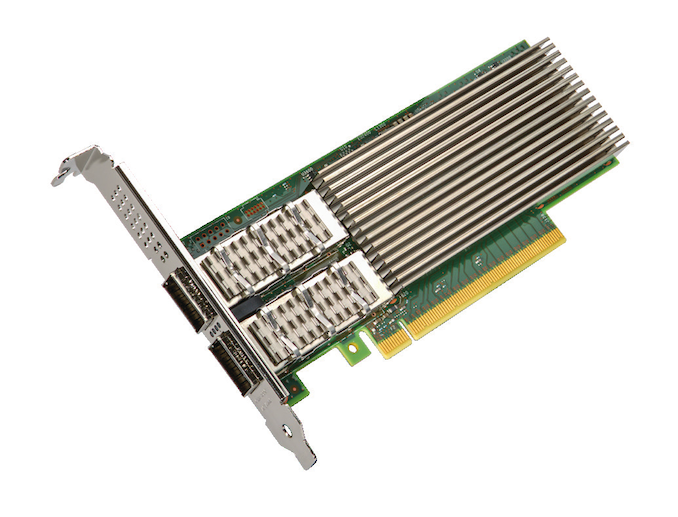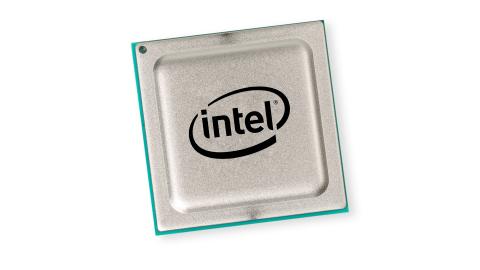Intel Ethernet 800 Series To Support NVMe over TCP, PCIe 4.0
by Billy Tallis on September 24, 2019 3:30 PM EST- Posted in
- Networking
- Intel
- Ethernet
- PCIe 4.0
- NVMeoF
- 100G
- 100G Ethernet
- Columbiaville

Today at the SNIA Storage Developer Conference, Intel is sharing more information about their 100Gb Ethernet chips, first announced in April and due to hit the market next month. The upcoming 800 Series Ethernet controllers and adapters will be Intel's first 100Gb Ethernet solutions, and also feature expanded capabilities for hardware accelerated packet processing. Intel is now announcing that they have implemented support for the TCP transport of NVMe over Fabrics using the Application Device Queues (ADQ) technology that the 800 Series is introducing.
NVMe over Fabrics has become the SAN protocol of choice for new systems, allowing for remote access to storage with just a few microseconds of extra latency compared to local NVMe SSD access. NVMeoF was initially defined to support two transport protocols: Fibre Channel and RDMA, which can be provided by Infiniband, iWARP and RoCE capable NICs. Intel already provides iWARP support on their X722 NICs, and RoCEv2 support was previously announced for the 800 Series. However, in the past year much of the interest in NVMeoF has shifted to the new NVMe over TCP transport specification, which makes NVMeoF usable over any IP network without requiring high-end RDMA-capable NICs or other niche network hardware. The NVMe over TCP spec was finalized in November 2018 and opened the doors to much wider use of NVMe over Fabrics.
Software-based NVMe over TCP implementations can use any network hardware, but for the high-performance applications that were originally the focus of NVMe over Fabrics, hardware acceleration is still required. Intel's ADQ functionality can be used to provide some acceleration of NVMe over TCP, and they are contributing code to support this in the Linux kernel. This makes the 800 Series Ethernet adapters capable of using NVMe over TCP with latency almost as low as RDMA-based NVMe over Fabrics. Intel has also announced that Lightbit Labs, one of the major commercial proponents of NVMe over TCP, will be adding ADQ support to their disaggregated storage solutions.
Unrelated to NVMe over Fabrics, Intel has also announced that Aerospike 4.7 will be the first commercial database to make use of ADQ acceleration, and Aerospike will be publishing their own performance measurements showing improvements to throughput and QoS.
The Intel Ethernet Controller E810 and four 800 Series Ethernet adapters will be available from numerous distributors and OEMs over the next several weeks. The product brief for the E810 controller has been posted, and indicates that it supports up to a PCIe 4.0 x16 host interface—to be expected from a 100Gb NIC, but not something Intel PR is keen to highlight while their CPUs are still on PCIe 3.0.
Related Reading
- Intel Columbiaville: 800 Series Ethernet at 100G, with ADQ and DDP
- Intel’s Enterprise Extravaganza 2019: Launching Cascade Lake, Optane DCPMM, Agilex FPGAs, 100G Ethernet, and Xeon D-1600
- NVIDIA To Acquire Datacenter Networking Firm Mellanox for $6.9 Billion
- Western Digital to Exit Storage Systems: Sells Off IntelliFlash Division
- Marvell at FMS 2019: NVMe Over Fabrics Controllers, AI On SSD











48 Comments
View All Comments
azfacea - Tuesday, September 24, 2019 - link
As an intel shareholder I am so glad they have successful hid the 2.5 gig ethernet IP from the consumer market for the past 5 years. Clearly that would put their data center business at risk .... History shows that this is the best way to maximize profits and it also involves no risk of losing core business to companies with 10% as many employeesextide - Tuesday, September 24, 2019 - link
You forgot the /sLol, but seriously, why hasn't Intel jumped on the NBASE-T bandwagon yet ? Obviously we need to get more switches and stuff supported but yeah 2.5/5GB is perfect for home use and should have been rolled out years ago. Sheesh.
Ian Cutress - Tuesday, September 24, 2019 - link
I was told that current 2.5G solutions had a two year lead in the market. Three years ago. /shrugmooninite - Tuesday, September 24, 2019 - link
So the future of Ethernet appears to be dead. Lackluster Wi-fi 6 products are what we have to live with.Why is the industry afraid of investing in 2.5/5G devices?
azfacea - Tuesday, September 24, 2019 - link
WIFI is a complete non-starter for gaming. 1ms latency from PC to router becomes 30 ms on average and 90ms occasionally when there is re-transmission. slow and inconsistent. i'd rather be dead in a ditch than play csgo on wifi.As for the 2nd part. I really don't know. Intel has had this IP in their library for many years. Its not a large piece of sillicon either. If I am not wrong Aquentia had pure CMOS 10GBASE-T controllers back in 65nm days. NBASE-T in 45nm or 28nm.
Alistair - Tuesday, September 24, 2019 - link
dead in a ditch, hehebrunis.dk - Wednesday, September 25, 2019 - link
I'm guessing by Aquentia, you mean Aquantia?DanNeely - Wednesday, September 25, 2019 - link
On bigger lithographies 10GBASE-T controllers ran hot enough they needed substantial heat sinks to keep cool. A few years back the estimate was that heatsinkless controllers would be possible in one or two process shrinks. I don't recall if that was 14 or 10 anymore. On Intel's side neither are really an option, 10 is apparently never going to be a volume tech for them and it's delays mean 14 is fully tied up on CPUs. For Samsung/TSMC with high performance/dollar parts moving to 7nm the capacity on 14/12/10 should be opening up for more cost sensitive customers.Otherwise we seem to be stuck at the chicken/egg problem. No cheap 2.5/5/10g consumer routers means no demand for matching cheap 2.5/5/10g consumer network adapters and vice version. At least on Intel's side it's possible the plan was to have multi-gig ethernet support baked into chipsets by now; but that like everything else their tight coupling of process tech to hardware design and cpu to chipset models has resulted in the 10nm debacle preventing them from coming out. I'm really eager to see what the chipset for their upcoming 10nm Xeon's will support, since integration there would be a harbinger of things to come on the consumer side. AMD's only just gone from a fully outsourced chipset to a nominally in house one mostly full of 3rd party IP, so not having any sort of native multi-gig yet doesn't surprise me. Again it'll be interesting to see what happens with their next one; will they stay with needing a full up controller over PCIe or do what Intel's done and pull a large chunk of it into the chipset to encourage using their branded networking parts to finish the setup.
bcronce - Wednesday, September 25, 2019 - link
Intel 4 core Atom Xeon with passive cooling are SoC with 10Gb integrated into their 14nm. The dual 10Gb plus 4 cores running at max are passively cooled, not to mention the chip plus motherboard are only $200. You can get a 14nm SoC Xeon with integrated dual 10Gb NICs for the same price as a single 20nm class 10Gb NIC. That's the difference between 20nm class and 10nm class for networking.IamSorryDave - Wednesday, September 25, 2019 - link
Which CPU+mb for $200 were you referring to? The ones (with C3xxx) I am aware of are double that in price.